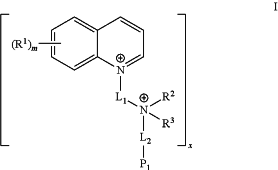| CPC A61K 49/0054 (2013.01) [A61K 47/61 (2017.08); A61K 47/6929 (2017.08); A61K 49/0021 (2013.01); A61K 49/0032 (2013.01); A61K 49/0052 (2013.01); A61K 49/10 (2013.01); A61K 51/0491 (2013.01); A61K 51/0497 (2013.01); C07D 221/12 (2013.01); C07D 413/06 (2013.01); C07D 417/06 (2013.01)] | 14 Claims |
|
1. A nucleic acid binding nanoprobe having structure of Formula I:
 or a pharmaceutically acceptable salt thereof;
wherein:
each L1 is independently C2-20 alkylene;
each L2 is independently C2-20 alkylene, wherein any of the carbons in the C2-20 alkylene chain is optionally replaced with C(O), O, S, S(O), S(O)2, NRa1 NRb1C(O), or a triazole;
P1 is a polysaccharide;
each R1 is independently (CH)t-5-10 membered heteroaryl, (CH)u-5-10 membered heterocycloalkyl, C6-10 aryl, or NRa2Rb2; wherein each 5-10 membered heteroaryl and 5-10 membered heterocycloalkyl has at least one ring-forming carbon atom and 1, 2, 3, or 4 ring-forming N or S atoms; and wherein the C6-10 aryl, 5-10 membered heteroaryl, and 5-10 membered heterocycloalkyl are each optionally substituted with 1, 2, or 3 substituents independently selected from C1-6 alkyl, NH2, NH(C1-6 alkyl), and N(C1-6 alkyl)2;
or two R1 adjacent to each other and together with the carbon atoms to which they are attached form an C6-10 aryl; wherein the C6-10 aryl is optionally substituted with 1, 2, 3, or 4 substituents independently selected from C1-6 alkyl, NH2, NH(C1-6 alkyl), and N(C1-6 alkyl)2;
R2 and R3 are independently selected from H and C1-6 alkyl;
each Ra1, Rb1, Ra2, and Rb2 is independently selected from H and C1-6 alkyl;
m is 1, 2, 3, or 4;
t is 1, 2, 3, 4, 5, or 6;
u is 1, 2, 3, 4, 5, or 6;
x is about 2 to about 20, and
wherein the nanoprobe does not comprise a metal.
|